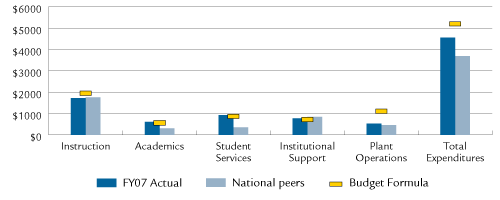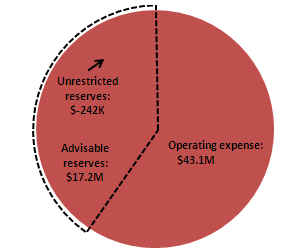Northern Essex
The mission of Northern Essex Community College (NECC) is to serve the people of the greater Merrimack Valley as a caring and comprehensive center of educational excellence that offers high-quality, affordable adult and post-secondary education through the associate's degree level, as well as a broad range of occupational programs and community services which enhance the social, cultural, and economic life of the region.
Program of Distinction
Collaborations
Access Indicators
Affordability Indicators
Student Success and Academic Quality Indicators
Fiscal Effectiveness and Efficiency Indicators
Program of Distinction
Northern Essex Community College (NECC) has joined more than 80 community colleges nationwide, including four in Massachusetts, in the national Achieving the Dream initiative. Achieving the Dream is designed to close student success gaps, particularly among low-income and minority students, by focusing attention and resources where they will have the biggest impact. Through the project, NECC aims to improve student grades, retention, graduation and transfer rates. After spending the last year rigorously analyzing data about its students' success, NECC is now implementing strategies including the creation of a mathematics laboratory, the development of modular math curriculum, a supplemental instruction program and an "EPortfolio" system for academic advising.
Collaborations
- One of the surest paths to success in college is readiness after high school. NECC has been working closely with several area high schools on a number of initiatives designed to prepare students in the Merrimack Valley for college success. In one particularly successful partnership, NECC and Methuen High School collaborated to provide early placement testing to more than 400 high school juniors. The College followed this effort with developmental Math classes for more than 40 students at the college, and an Algebra course offered at the high school with assistance from the Massachusetts Department of Higher Education Dual Enrollment initiative. Future plans include joint professional development and curriculum alignment activities with high school and college faculty.
- NECC has been working with North Shore Community College, Massachusetts Colleges Online, and Salem State College for a 1 + 1 + 2 articulation to a 100% online Fire Science program. NECC does not currently offer a Fire Science program, but our students will now be able to transfer their general education courses to NSCC to meet up to 30 credits of the requirements for the Associate of Science in Fire Science. Graduates can then transfer to Salem State's online BS program. This agreement provides new education and career opportunities to students in the Merrimack Valley, while making efficient use of resources at all of the colleges involved.
- NECC, in collaboration with Associated Grant Makers of Massachusetts (AGM) and a local not-for-profit, Jericho Road Lawrence, Inc. have opened the Merrimack Valley Grant Resource Center (GRC) at the Lawrence campus. This center is the first of its kind in the state. The GRC allows for free access for all area non-profits and individuals to the AGM funders' directory and The Foundation Center online database with trained staff to guide them in their fundraising endeavors. AGM also facilitates a series of fall and spring workshops at NECC for nonprofits at no charge: Grant Research, In-Depth Database Mining and Introduction to Grant Writing. NECC has already reached out to more than 90 area nonprofits from Amesbury to Lowell through the Center and views the GRC as one way NECC can continue to be the "first and best resource for our community."
- The Northeast Partnership for Hospitality and Tourism (comprised of North Shore, Northern Essex, and Middlesex community colleges as well as a host of area businesses in the hospitality field), has embarked on a two-year planning and implementation project to serve both potential new workers as well as incumbent workers in the hospitality industry in the general Northeast region of Massachusetts.
- Northern Essex Community College offers a number of programs funded by the Massachusetts Department of Elementary and Secondary Education (DESE) under that agency's Adult Basic Education (ABE), Workplace Education, and Adult Basic Education Transition to Community Colleges Programs; through the Department of Higher Education McNair Programs; the Commonwealth Corporation; and the Nellie Mae Education Foundation. The objectives for all adult learners are to improve reading, writing, math, English language and basic computer skills, as well as provide assistance with GED preparation and access to community college. Collaborating agencies include Haverhill Community Action, Inc; the Amesbury Public Library; the Lawrence Public Schools; the Asian Center of the Merrimack Valley; the Notre Dame Education Center, the Boys and Girls Club of Lawrence, the Merrimack Valley Workforce Investment Board and the Valley Works Career Center.
Section I: Access to Public Higher Education in Massachusetts
Access Indicators
Fall 2007 Enrollment
| Headcount |
6,526 |
| FTE |
3,849 |
Fall Enrollment
Over the last three years, fall headcount enrollment has increased 2.6%.
Over the last three years, fall full-time equivalent (FTE) enrollment has increased 3.8%.
Annual 2007–2008 Enrollment
| Headcount |
8,831 |
| FTE |
3,839 |
Annual Enrollment
Over the last three years, annual headcount enrollment has remained relatively stable.
Over the last three years, annual FTE enrollment has remained relatively stable.
Looking Back: Fall and Annual Headcount Enrollment

Fall 2007 Minority Enrollment
29.5%
Minority Enrollment
Greater than the minority representation of the institution's primary draw cities and towns (21.7%) and the Northeast Region's minority representation of 14.5%.
Section II: Affordability of Massachusetts Community Colleges
Affordability Indicator
2007–2008 Tuition and Fees as a Percent of Median Family Income
4.4%
% of Median Family Income
Comparable to the Northeast regional average of 4.9%.
Looking Back: Tuition and Fees as a Percent of Median Family Income
|
FY2004 |
FY2005 |
FY2006 |
FY2007 |
FY2008 |
| Northern Essex Community College Tuition and Fees |
$2,970 |
$2,970 |
$3,150 |
$3,150 |
$3,420 |
| State Median Family Income |
$67,527 |
$68,701 |
$71,655 |
$74,463 |
$78,497 |
| "X" as a Percent of State Median Family Income |
| X = Northern Essex Community College Tuition and Fees |
4.4% |
4.3% |
4.4% |
4.2% |
4.4% |
| X = Massachusetts Community Colleges' Average Tuition and Fees |
4.8% |
4.9% |
4.9% |
4.7% |
4.7% |
| X = Northeast Average Tuition and Fees |
|
4.8% |
4.8% |
4.9% |
4.9% |
Section III: Student Success and Academic Quality
Success and Quality Indicators
Fall 2006 Cohort First-Year Persistence Rate
| Retained at original institution |
56.1% |
| Retained at any institution |
64.9% |
Fall Cohort First-Year Persistence
Persistence at original institution has decreased 3.6 percentage points over the last three years but is comparable to the segmental average of 56.5%.
Looking Back: Fall-to-Fall First-Year Persistence Rate

Fall 2003 Cohort Four-Year Overall Success Rate
69%
Fall 2003 Cohort Four-Year Individual Success Rates
| Earned Degree/Certificate |
32.8% |
| Transferred |
16.5% |
| Earned 30 Credits |
16.6% |
| Still Enrolled |
3.0% |
| Note: Each subsequent category excludes any student included in previous category(ies) |
Fall Cohort Four-Year Overall Success Rate
This new indicator measures students who have earned a degree/certificate, transferred to another institution, earned 30 or more credits, or are still enrolled after four years. Future reports will include these outcomes over four, five, and six years for this and successive cohorts. Please see the Technical Guide for further details regarding this indicator.
2007–2008 Fall-to-Spring Retention Rate
92.8%
Fall-to-Spring Retention Rate
Fall-to-spring retention has remained relatively stable over the last three years.
FY2008 Credit Course Completion Rate
72.3%
Course Completion
Below the Board of Higher Education's target rate of 75%.
Total Degrees Conferred in FY2008
843
Degrees Conferred
Average degrees conferred per year over the last three years: 806
Looking Back: Degrees Conferred

2007 Pass Rate on the National Nursing Licensure Examination
91%
Nursing Exam Pass Rate
Above the Board of Higher Education's target pass rate of 85%.
FY2008 Annual Enrollment in Workforce Development Courses
5,291
Workforce Development
Average annual enrollment in workforce development courses per year over the last three years: 12,430
Section IV: Effective and Efficient Use of Resources
Effectiveness and Efficiency Indicators
Effective Projects and Initiatives
- Supported the President's Climate Commitment by initiating NECC: Healthy Living, Healthy Planet; completed projects include college's carbon footprint baseline; whole building energy audit of all Haverhill campus facilities; rubber tile replacement in three buildings; ride share incentive; and returning areas to natural landscape.
- Promoted open, fair competition in procurement by completing request for proposals (RFP) for security, campus-to-campus shuttle, child care center, vending, and food and catering services.
- Demonstrated college commitment to accountability, transparency, and excellence in financial reporting by completing the FY2008 comprehensive annual financial report (CAFR) and submitting it to the Government Finance Officers Association (GFOA) for review. The CAFR initiative was done in partnership with Fitchburg State College.
Resource Allocation
Expenditures per Student—Actual, National Peers, and Budget Formula

Note: This graphic was revised on May 6, 2009. The previously posted graphic displayed the data inaccurately.
FY2008 Primary Reserve Ratio
| Unrestricted Reserves (UR) |
-$242,441 |
| Total Operating Expenses (TOE) |
$43,118,048 |
| Primary Reserve Ratio (UR/TOE) |
-0.6% |
Primary Reserve Ratio

Compliance
No materials weaknesses based on annual external independent audit:

